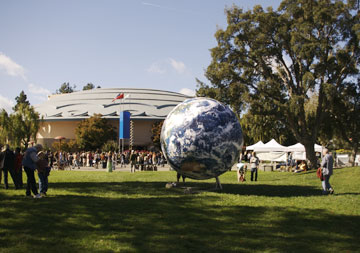
After the soul-grounding performance of all-women percussion and voice ensemble Ojala, the 2nd day of Bioneers again starts with a pre-plenary welcome from Nina Simons and Kenny Ausabel.
This time the roles are reversed and Nina is the one addressing systemic change, publicly acknowledging each Beaming BIoneers satellite location, and Kenny Ausabel speaking emotionally and personally about Bioneer family member John Mohawk who died since the last gathering.
Paul Anastas
“Father of green chemistry” Paul Anastas gave an intelligent & cogent presentation about the central role that chemistry plays in absolutely everything. He argued that the power of chemistry gives both the ability to introduce new substances and responsibility for the consequences of those substances.
What was amazing to me was how simple a shift in perspective it would take to switch our current approach and move to a world powered by green chemistry. Why haven’t we been doing this all along? Anastas’ facts expose the myth that we can’t have all the advantages of our modern culture unless we poison ourselves. Instead, he explains, green chemistry can provide all the benefits we enjoy today PLUS deliver them sustainably and reliably, without harming our bodies or the environment. What are we waiting for?
Majora Carter
Sustainable South Bronx Executive Director Marjora Carter, who has worked so hard to beautify her own economically poor neighborhood, is herself a stunningly beautiful presence on the stage. Recalling Van Jones’ passion, her talk was an emotionally powerful description of the plight of “regional sacrifice zones” like the one in the South Bronx where she grew up. A location where prisons and broken prisons and garbage are two of America’s fastest growing industries because they are (seen as being) more profitable than investment in the community.
Carter says “Environmental justice is civil rights in the 21st Century” and advocates ‘Green for All’, insisting “You shouldn’t have to have a ton of green in order to be green – environmentalism is not just a niche thing for the super-wealthy.” She went on to tie the issue of poverty to the core of the green agenda with the development of “green collar” jobs; “Environmentalism should move our country out of poverty – we need to learn how to profit from equality.”
The creativity that went into clearing an illegal garbage dump and making it into a lovely waterfront park carries on in other Sustainable South Bronx projects to re-connect the community to the earth. Residential and commercial Green Roofs, along with an proposed Greenway that will provide healthy access to open space, are changing the landscape of their city.
Evon Peter
Something else amazing happened next. Twenty-eight young indigenous leaders came out onto the stage and silently formed a circle, blessing the space and showing gratitude with offerings of cornmeal and prayer bags. Then they sat, and after a hauntingly beautiful Hoopla song by two young native women, each one introduced themselves in their own tongue, saying their names and the land from which they had come.
Kriston Rothballer, former Bioneer program director and a young woman of Norwegian /German descent was there to introduce Evon Peter, National Director of Native Movement. She spoke last, speaking her gratitude at being included in this circle and introducing herself with both pride in her ancestry and heart-felt shame and remorse for what those ancestors had done to the ancestors of the native peoples sharing the stage.
Evon, who is himself half native Alaskan and half Jewish, began by welcoming us on behalf of his brothers and sisters, as a guest in their lands. He warned that he was not here to speak words that would please us, and honored each of those on the stage acknowledging the difficulty with which they stand before us. He acknowledged the people who had been brought here against their will and enslaved, and welcomed them as well. He acknowledged the lesbian, the gay and transgendered, saying they are doing the important work of being who they really are.
He said that without sprit we will not find the answer, that it’s of major importance for us to learn how to stop disrespecting the indigenous peoples, to learn what it is that needs to be learned from them, and let go of our ignorance. Just because we are wealthy, he warned, or intelligent, or have a big name does not mean we know more than others, or understand what needs to be understood now.
His closing remarks were “If you’re not ready to respect us in our home it’s time for you to go back to where you came from,” assuring us that he speaks those words with love in his heart, knowing we ARE ready.
Eve Enzler
After a break Nina introduced the influential and incredibly successfully author of the Vagina Monologues and VDay founder, Eve Ensler. Eve talked about the contradictions at the core of her work and her attempts to live in the middle of them with grace and balance, launching a movement that is at the same time fluid and concrete and has the qualities that can both spread easily and retain the integrity.
Eve gave a rousing speech about the gains we have achieved in stopping violence against women, and the horrors of how far we have to go, of how important women are to the very heart of life itself. One of my favorite lines was about how we had not yet elected or become the leaders who would make this or that change. The only point of having power is to give it away or inspire it in others, she says, encouraging us all to “leave the Father’s house”, the patriarchal model that we have all grown up within with an invigorating reading of her power-poem “I’m LEAVING my Father’s House!”
Edward Tick:
Psychologist and Executive Director of Mentor the Soul, Edward Tick believes the wounds of war are collective cultural wounds, and his work as a healer of the damage caused by violence and war is to help us find the spiritual courage to restore those wounds and end the violence together.
Tick assures us that post traumatic stress disorder, which is so much in the news right now, is not an individual mental disorder; it is a collective trauma from the brutalization of the world. He argues that the psychological trauma of war is worse than any of its other admittedly terrible effects. “It is impossible to perpetrate war in this day and life without becoming psychopathic,” he insists.
Our world is populated by the ghosts of war, Dr. Tick says, and they are possessing us all. PTSD, which can be described as Post Traumatic Soul Disorder, is a soul wound, a cry of the soul trapped in the underworld. It makes the whole world look like a war zone to the sufferer, and the soul shrinks in the face of it.
In the civil war PTSD was called “soldier’s heart” – we cannot expect to be pain-free as long as we are killing each other. But PTSD is also Post Terror Social Disorder – it is not normal, Tick continued, for us to “go shopping” when the world is at war. Further, PSTD is also an identity disorder. To cure it, we have to find the ‘who we are’ that includes the wound, and bring it back to our tribe, he says, since the cure is to be found in spirituality and community.
Traditionally, warriors are peace-makers and they become warriors through an initiatory process that takes them down to hell and then brings them through it, transforming them into beings who understand the world and what it takes to live within it. PSTD is an incomplete initiation, Tick explains, where the warriors are stuck in hell, and he insists we need to go down and meet them there – where he admits our hearts will also be broken – but we can come back from hell together. PTSD sounds a citizen call to action, to bring the warriors back into the tribal circle.
Before lunch I went back to the Web2.0 room and took a tour of Wiser Earth, where I was surprised to find that beyond the fabulous directory that founder Paul Hawken had spoken about in his Bioneers plenary session last year, it has evolved into a social networking site. I must admit I was a little dismayed to see yet another one, when to my mind the work they are doing in connecting the network is so much more unique and compelling than jumping into an already crowded arena. I’d prefer to see them extend the same directory service to the social networking sites that are already out there.
After lunch I attended my choices of the two blocks of afternoon sessions.
Mainstreaming Hope through Popular Media
This panel was chaired by KPFA’s Free Forum host Terence McNally, who opened the table for his colleagues.
Educator and Filmmaker Jeremy Kagan showed a variety of clips from his work in both documentary and mainstream media and addressed the question that critical Media Studies students always ask – “How does media effect the public?” Citing three segments of the ‘public’ – the ‘enemy’, the ‘undecided’ and the ‘choir’ – Kagan says we imagine we should be focusing on the undecided, but studies show that putting our attention on galvanizing the choir can be a far more powerful strategy.
He brought up a number of additional points that effect this question, including four phases of awareness:
- Pre-contemplative – you don’t even know there is a problem
- Contemplative – you know there is a problem but have no idea what to do about it
- Preparatory – You know there is a problem and are listening to and hearing possible solutions
- Change – you are going home and actually making change happen
We know that those who control the media have an advantage in terms of influence, he continued, but what happens once we have control? The adrenaline rush of fear or excitement in contemporary media holds attention, but it does not necessary evoke action. He mentioned soap operas plots in Mexico and India that have taken on social issues as being potential vehicles for social change.
Kagan addressed the concept of the ‘mirrored nuant’ or identification with the hero or heroine, and how important this makes the question of how you leave the audience at the end of the film. Is it with a conventional “happy ending” or is a sense of “this issue is not solved, and now it’s your responsibility” more effective?
In conclusion, he mentioned redundancy – the value and drawbacks of hearing about issues over and over – and brought up the very important phenomenon of secondary dialogue, where a film is effective not because someone saw the movie and was directly effected by it themselves, but because of the conversation it engendered in the public afterwards.
Tree Media’s Leila Connors, who co-produced & co-wrote The Eleventh Hour, described life in the middle of a film release. She talked about the intention behind their film, which was to create change and action on the ground, and the challenge they’ve had in getting it out there so it can start fulfilling its intention.
After the film was finished and had gone through a number of initial showings, they sold The 11th Hour to Warner Independent Pictures where it will be released around the world between now and July 2008. Lila talked about the frustration of sitting on top of a film that everyone wants to see but no one knows how, and the grassroots campaign they are launching in response.
Leila’s sister and Tree Media colleague Nadia Connors spoke about the stages they’ve gone through in getting people behind this film project. She found that the journey to get there was difficult for many people, and yet for others it changed their world. Since their intention with the film was to create a cultural shift in consciousness – through hope and love rather than fear and hatred – having people “get it” was of utmost importance to them.
But cultural change can take time, Nadia reminds us, and the world of film is more often a quick flick-through, part of the culture of greed and speed that robs us of time to really sit with an idea and allow the story to filter through.
TV Producer, screenwriter and storytelling guru Paul Lussier wants to see climate change narratives embedded in media stories, but says this has proved to be remarkably complicated. We know that sex, power and violence sells, and MAYBE eco sells… but how well does it sell? Is eco selling the same as eco solving?
(He showed an amusing little video to illustrate his point, which I have tried to find for you on YouTube, to no avail. Sorry!)
The secret to successful media, Lussier confides, is speaking to the ‘id’ – which so far we have we all assumed is stimulated by sex, money, and power. But Lussier says the truth is more that the id is moved by what really matters to us – the challenges and fears and visions that move us all. To back up this insight, he has committed his company’s programming to airing positive stories that make a difference.
To start off the Q&A, Terence McNally asks the rest of the panel about the traditional method of using sex, violence and tension as the “sell” – “Where is the ‘hook’ for the new narrative?” he challenges.
Nadia points out that there are already successful narratives that don’t depend on the old model to attract our attention – citing Into the Wild as a recent example- and Lila followed with the hope we will evolve beyond the current paradigm to where we can just simply watch something because it is beautiful. As we continue to spiritually evolve our stories will change to reflect our new level of consciousness, she says; we have to keep pushing against the idea that tension is the only thing to galvanize our attention.
Jeremy says he disagrees with the entire premise – Buddha’s story has tension and drama, he argues, the question is whether we can raise consciousness using the same dramatic techniques.
Opening up the conversation, the audience also had some informative contributions to make, including the announcement of an Environmental Film Festival in Nevada City, CA.
One audience member pointed to The End of Suburbia – a grassroots documentary film-making success:
The follow up Escape from Suburbia was less successful, in part because solutions are harder to sell than problems, given the drama & challenge that these problems hold.
Lila and Nadia responded by admitting that’s one reason why they put both together in one film, and Paul added that the real key is in making it personal – get the identification going to create a relationship, he says, and the audience engagement will carry you through.
My last session of the day was a panel called Women Re-Imaging the World.
The panel was presented as a series of questions from the chairwoman Akaya Windwood of the Rockwood Leadership Program, to the Panel, consisting of author Alice Walker, Buddhist activist Joanna Macy, Nina Simons, co-founder of Bioneers, and Jungian psychiatrist Jean Shinoda Bolen, and Sarah Crowell, Executive Director of Destiny Arts.
Why women?
(Joanna) Because the era of the patriarchy is ending.
(Alice) It’s time we showed what we can do.
(Sarah) We’re out of balance, partly because the patriarchal system has held the power, and it’s time to bring us back into balance.
(Nina) We are all wounded by the loss of the feminine, so one of the greatest gifts we can bring to the world is its restoration … and as women we have a certain leg-up on what they looks and feels like.
Referencing Mary Oliver’s famous poem about letting the soft warm animal of our bodies love what they love – What is the rightful relationship between women and our animal bodies?
(Joanna) A terrible thing has happened in our culture – the cut across our base chakra that allows us to use our brains to learn how to shatter flesh. We’ve lost our erotic connection to life, and need to regain it – fast – to relieve ourselves of the terrible loneliness that occurs when we cut ourselves off from our own bodies and the rest of life. Praise be to our bodies that will make us sane again.
(Alice) I think Mary Oliver is right to say we should let our bodies love what they love, because when we do that we break every possible law, and it’s very energizing!
(Sarah) The young women I teach dance to are exposed to a lot of sexuality through the media, some of which I think is good because it means sex isn’t hidden. I get to tell them, “Sex is good” AND it’s yours! When you shake that booty, shake it for you. Own your body; don’t give the power away.
(Nina) We all live within a culture that makes us think our minds are so smart… part of re-imagining the world is knowing that we have everything that we need – and part of that is in our bodies and in our hearts.
(Alice) For me lately the journey has been getting closer to the other animals. I’ve been feeling really married to my dog and my cat, and I’ve learned from them what it is to really be in my body and feel the sun on my face, feeling myself as just another of the animals on the planet.
What’s your wisdom about setting limits and boundaries within a framework of inclusion that creates a space for other?
(Joanna) It’s an important question – our world is threatened with extinction because we don’t have clear limits. Perhaps women are better at this – I’m proud to see how women have set limits to how we treat the earth.
(Alice) I think it’s good to set limits and am astounded at how hard it is to do that sometimes, to say “no, not now”. We have to really work to build the strength in ourselves to hold that boundary. We’re in for a rough ride and will have to make some tough decisions about what we’re about and who we want to be with.
(Jean) Women’s natural form is to gather in circle and discuss what needs to be done, together; to have sisters at your back. The more we do it the easier it is for others to do it, too.
(Sarah) The no and the yes are each as fierce as the other. She has us stand up for a quick yes / no boundary setting exercise that gets us moving our bodies and exercising our vocal chords a bit …
(Nina) This question of boundaries has me going… I’m much more comfortable with a sense of boundary-less-ness but learning to cultivate boundaries within what I’m categorizing as a healthy masculinity. Finding the balance between how much we need to be connecting with each other through empathic connection, and what it means to cultivate limits in ourselves, and feel the ‘anger in our feet’, the “no”, or what needs to take a stand inside.
What lies under your despair, and what wisdom can you offer us from that place?
(Joanna) By honoring our despair and not trying to personalize or pathologize it, it can be a gateway to our full vitality and connection with all humanity. Under our despair is our heart, our sorrow over losses that are unrecoverable. On the other side of our pain for the world is a love so great you would never guess its vastness, but to get there you have to stop being afraid of hurting because they come from the same source and are like two sides of the same coin.
(Nina) Under my despair is yearning… it’s frightening to really let myself feel how big the love is. Because of my fears of investing in that, it’s scary to really show how much I care and admit how much I want it, but it’s also what keeps me doing what I’m doing.
(Joanna) It is dangerous – for the status quo, for business as usual.
(Alice) What’s on the other side of my despair is ecstasy – to be here in the now. Not in the future, or the past, but right now. It is such a gift. The despair is that thick covering of ice. When I allow myself to experience eternity – which is in the moment – when I rest enough to give that back to myself, then I know its all ok. Mother has all the time there is and she’ll melt this ice ball many times. She’s left me here to be a witness to her beauty and her grace, and that’s the ecstasy I feel.
(Jean) The reason for my optimism is that there has never been a generation like this – all the men and women effected by the women’s movement who are still young enough to make a difference. We have a sort of synchronistic grace on our sides. This is a seminal time, a great time to be alive.
What are the practical things you would suggest to help us in re-imagining the world?
(Sarah) Showing up every day as open as you can – open and raw – I experience what I call ‘the trembling’ as often as I can. That and “being real” with my kids.
(Jean) Doing my assignment – which is to listen to the opportunities that come my way and answering these three questions in response to their invitation… Is it meaningful to me? Will it be fun? Is it motivated by love? So my answer is ‘gather the women; save the world’. Simple, really.
(Alice) Sometimes it’s hard to know where you will serve next. For example, all those speeches to try and stop the war … I still do that but at some point I realized we have to make a shift in our children’s consciousness about war. M any of them think it’s a game, so I personally felt I had to move from making speeches to writing a children’s book about war.
So, my answer is ‘hard work’; at this point it’s all about service and finding the joy of that.
(Nina) I pay exquisite attention internally to see what makes my flame glow brighter. I’ve learned there is ecstasy in service to that. There is immense power in connecting our inner work (what you most love) to what is most needed in the world. Now is the time.
(Joanna) I would only add – take a moment to build the larger context into your world view. I’ve just returned form 30 days in the wilderness with 60 people where we did take that time. Our sense of time is fragmented and driven and hurried, so we were slowing down to fourth time, as they say in Buddhism, to a time beyond our lifetime. That was extremely liberating, not to be attached to the results of your action, to just act because it is what you must do, what is right to do. And … it makes us act our age. To experience the grace and beauty of our true age.
Then we moved to questions from the Audience:
How do you listen to your inner self in order to make the right decisions?
(Alice) I pay a lot of attention to my dreams and protect my dreamspace from conversation, TV, etc. before bed that would disturb us. This ability to dream was given to us in ancient times, as a guide for our lives; it is our heritage.
What of the pull to give birth to new life?
(Joanna) Don’t let anyone else make up your mind but remember that in this time of the great turning we need children that are loved. You can have your own or you can adopt; we need all the beings who want to enter this world and enjoy the fruits of your activism.
What do we do to support a re-emerging of the feminine?
(Alice) Be feminine, and stop calling yourselves “guys”
(Nina) Head into my fear, and love myself.
How do we raise our daughters while being activists and taking care of ourselves as well?
(Jean) You can’t do everything at once. There is always a priority – what you know in your bones is your sacred work, whatever it is. You can’t listen to the ‘shoulds’ from outside; it comes down to individual choice, but who makes the choice is what makes all the difference.
Someone shared that they feel they need to tell everyone about what’s happening in the world…
(Joanna) It’s not about telling anyone anything, but doing what you can to bring forward their listening to their own voices… we all know what is happening.
What is the best thing we can give our children?
(Alice) Once we have it, the truth.
What about all the wisdom coming out of young women?
(Nina) Reciprocal mentorship, where we who are older can reflect the beauty and wisdom of the younger women back to them.
My daughter loses hope sometimes. How can I help her?
(Joanna) Tell her not to be afraid of losing her hope. Tell her she can’t feel what’s on the other side without that.
(Alice) Remind her of the last time she lost her socks – losing hope is not the end.
Akaya ends the session with a final question for everyone on the panel to respond to-
What about gratitude?
(Jean) There were bright yellow aspens where I just was in Wyoming, and they are like pillars of light, of life. Hold on to what matters and when it becomes form, let it go. Every time you see something beautiful and think “ah” – that’s gratitude!
(Nina) Experiencing women with extraordinary capacity, courage and compassion that can love themselves back into health has been the most joyful thing I know.
(Sarah) This moment. I’m looking at the faces of people here who are great! Gratitude is pouring out like a waterfall in me for this very moment. Thank you!
(Alice) I actually do live in that place of amazement. We are so lucky – every day I wake up, amazed to wake up! It all seems so incredibly magical, and we are so incredibly lucky. Just to exist – to see this, to smell it, and wonder at it. How did this happen!?
(Joanna) I too am feeling the depth of this moment. Every question you’ve asked, everything that has come up here has had to do with your love for this earth. I don’t know when it’s ever happened before, but it’s happening now.

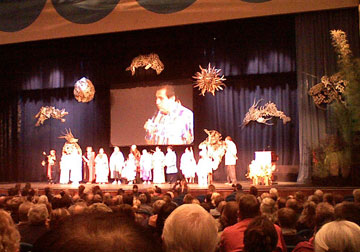
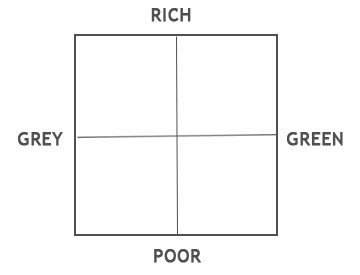
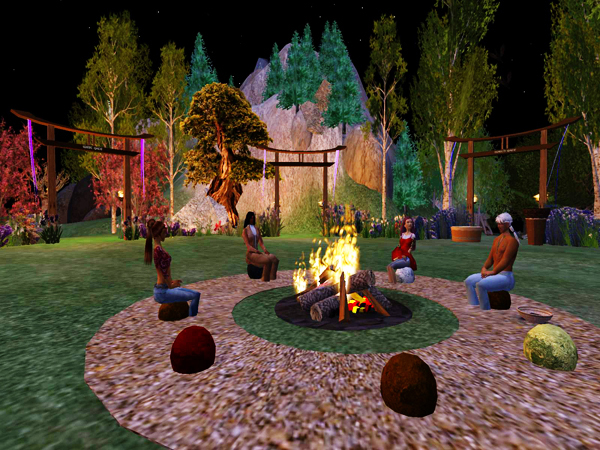
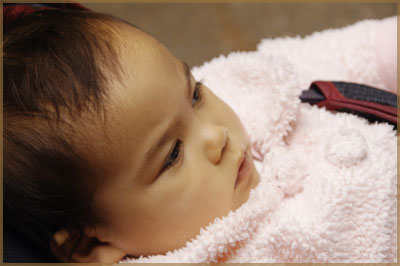
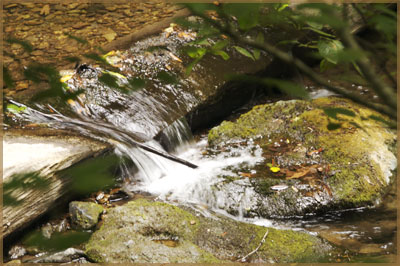

Welcome!